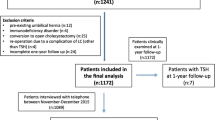Abstract
Background
Port-site hernia (PSH) is not a very rare complication following laparoscopic surgery. Incidence of PSH probably is a bit of understatement, as the common laparoscopic surgical procedures are not followed up on a regular basis in most parts of the world. This study aimed to review the present literature, current incidence and causes of PSH and to adopt a technically easier method to reduce the incidence of developing PSH following laparoscopic surgery.
Methods
In a series of 200 patients for laparoscopic appendectomy and laparoscopic cholecystectomy we introduced one 11 mm safety trocar just above or below the umbilicus at the paramedian site through the rectus abdominis muscle, avoiding the midline for the purpose of telescope insertion instead of making the port at umbilicus. The incidence of port- site hernia was calculated and the predisposing factors were considered.
Results
None out of 200 cases developed port site hernia in our 18-month follow-up, so in our study the incidence of PSH was 0%.
Conclusion
The incidence of PSH in a range of laparoscopic procedures varies. There is a rising incidence of PSH following laparoscopic colorectal, and bariatric surgeries as larger size ports are used quite often in those cases. The incidence of PSH following laparoscopic appendectomy and laparoscopic cholecystectomy can be minimized taking the predisposing factors into consideration and by adopting a easier modification of conventional technique.
Similar content being viewed by others
References
Hussain A, Mahmood H, Singhal T, et al. Long-term study of port-site incisional hernia after laparoscopic procedures. JSLS 2009;13:346–9.
Boldó E, Perez de Lucia G, Aracil JP, et al. Trocar site hernia after laparoscopic ventral hernia repair. Surg Endosc 2007;21:798–800.
McMurrick PJ, Polglase AL. Early incisional hernia after use of the 12mm port for laparoscopic surgery. Aust NZ J Surg 1993;63:574–5.
Bowrey DJ, Blom D, Crookes PF, et al. Risk factors and the prevalence of trocar site herniation after laparoscopic fundoplication. Surg Endosc 2001;15:663–6.
Johnson WH, Fecher AM, McMahon RL, et al. VersaStepTM trocar hernia rate in unclosed fascial defects in bariatric patients. Surg Endosc 2006;20:1584–6.
Eid GM, Collins J. Application of a trocar wound closure system designed for laparoscopic procedures in morbidly obese patients. Obes Surg 2005;15:871–3.
Tonouchi H, Ohmori Y, Kobayashi M, et al. Trocar site hernia. Arch Surg 2004;139:1248–56.
Author information
Authors and Affiliations
Corresponding author
Rights and permissions
About this article
Cite this article
Jamadar, N.S., Ray, D.K. & Das, S. Port site hernia in laparoscopic surgery: Way to prevent it. Hellenic J Surg 88, 402–404 (2016). https://doi.org/10.1007/s13126-016-0359-x
Received:
Accepted:
Published:
Issue Date:
DOI: https://doi.org/10.1007/s13126-016-0359-x



